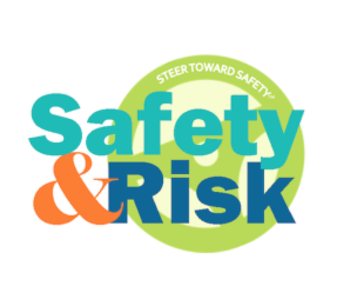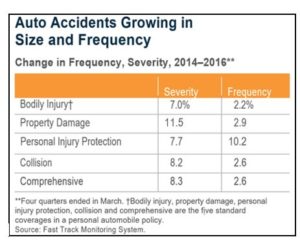
By Art Liggio, President and CEO, Driving Dynamics
Scratching your head? Can’t figure out why your crash rates and cost severity are going up? Shouldn’t vehicle safety technologies, which fleet operators are spending an arm and a leg on to fix these issues, produce different results?
An October 2016 report on crash rate frequency and severity provided by the Insurance Information Institutes (iii.org) gives us statistically good reasons to ponder these questions. Plus, preliminary 2017 data indicates similar results.
Obviously, there are a multitude of factors contributing to deteriorating results. Let’s take a look at some of the key drivers for rising cost severity.
- Aging Vehicles: While vehicle manufacturers have been playing catch-up these past few years (great for our economy), the Great Recession did change consumer buying habits with the average age of vehicles increasing by 20 percent over the past decade and increasing again in 2017. Even if properly maintained (and the maintenance levels of older vehicles is questionable), operators of older vehicles are more susceptible to greater harm. Contributing factors can include fewer airbags (e.g. no side airbags); unfixed repairs from prior crashes (e.g. compromised bumper absorption); lack of ABS braking systems (speed kills); and more.
- Mismatched Bumpers: Recent Insurance Institute for Highway Safety (IIHS) crash tests demonstrated huge repair costs when bumpers on cars and SUVs don’t line up (and many of them don’t). Even low-speed collisions produce more damage and higher repair costs. For example, a test was conducted in which a SUV going 10 miles per hour struck the back of a parked car. Then the configuration was reversed with the car striking the back of the SUV. Results of these low-speed impacts resulted in damages ranging from $850 to a high of $6,015!
- Collision Repair Costs: Enhancing vehicles with the latest high-tech safety equipment simply translates into significantly higher repair (usually replacement) costs.
- Increase of Legal Speed Limits: The recent trend in many states has been to increase legal speed limits. IIHS has determined that for each five mile per hour increase in the legal speed limit, traffic fatalities increase by four percent. A separate study by the National Institutes of Health indicates that each five miles per hour increases fatalities eight percent on interstates and freeways and four percent on other roadways.
- Affordable Care Act (ACA) Cost-Shifting: When enacted, the payment structure to medical providers, hospitals, etc., by health insurance carriers was changed (i.e. lowered). This resulted in the same service providers raising their charges to automobile insurance and workers compensation carriers who were not regulated by the ACA to offset their losses. Not only does this have a direct effect on cost severity but it also affects the size of liability claims as the amounts demanded by plaintiff attorneys is usually a multiple (this is a simplified explanation) of medical costs incurred by the plaintiff.
Reading through the items above which describe some of the contributors of increased crash cost severity, as a fleet and safety professional you can readily see that many factors are outside of your control. However, accident frequency, which we’ll discuss in the next article of this series, is a factor where you can positively influence outcomes and make a meaningful impact on crashes. Come back to read the next issue of Safety & Risk to learn how you can exercise greater control over you fleet’s crash rates and costs.
Safety & Risk is presented by Driving Dynamics an accomplished provider of impactful driver safety training and risk management services. Continually building and delivering programs based on sound research, proven learning methodologies and expert instruction, we are dedicated to improving drivers’ abilities to stay safe by leveraging risk management tools, principle-based learning and applied techniques. The One Second Advantage™ safety training principle developed by Driving Dynamics is rooted in research that shows 90 percent of all traffic crashes can be avoided when the driver has just one more second to react and knows what to do with that additional second. Driving Dynamics encourages all drivers to Steer Toward Safety™
Website: www.drivingdynamics.com; Email: [email protected]; Newsletter: www.mydriveradvantage.com
Steer Toward Safety and The One Second Advantage are trademarks of Driving Dynamics Inc. All Rights Reserved.


